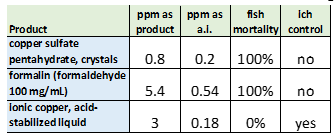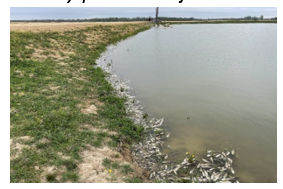EVALUATION OF IONIC COPPER FOR CONTROL OF ICH Ichthyophthirius multifiliis AT A COMMERIAL CATFISH FARM
The ciliate parasite Ichthyophthirius multifiliis , commonly known as ich, infects all species of freshwater fish and causes high rates of mortality and severe economic losses in commercial aquaculture. Historical methods of control have proven hazardous to people (malachite green was found to be cancerous and subsequently banned) and to fish, where the dose of formalin needed to kill ich is often fatal to the fish as well. There is a dire need for better and safer alternatives to prevent and cure ich within fish breeding operations .
In March 2021, Haring Farms (Franklin Parish, LA) received a delivery of hybrid catfish fingerlings intended for commercial production with in a new pond, and upon unloading noticed some dead carp in the delivery vessel. The g rower submitted samples of the cat fish for analysis by MSU's Aquatic Research & Diagnostic Lab, which confirmed the specimens were positive for ich .
At the recommendation of local ag advisors, the grower promptly began treating alternately with c opper sulfate pentahydrate ( 35 lbs /acre, 0.2 mg/L as copper), copper sulfate + c itric acid, and formalin (5.4 ppm), a formaldehyde-based product commonly used to treat for this infection. All the fish in the contaminated pond died (see figure) and the same process repeated in 3 more ponds, resulting in 100% fish mortality in 4 of the farm's 12 ponds , totaling more than $400,000 in direct losses and more than $1 million in lost opportunity cost .
A newly registered form of acid-stabilized liquid ionic copper was then trialed to treat the remaining 8 ponds known to be infected with the parasite, yet before m any fish had begun to die. The dosing protocol, abbreviated as 3+3+1, consisted of treatments using 3 ppm, 3 ppm and 1 ppm as product, equivalent to 0.18 + 0.18 + 0.06 mg/L as ionic copper , applied over the course of 7 days. Subsequent lab analysis confirmed eradication of the ich from all 8 remaining ponds without any further loss of fish. The same 3+3+1 protocol was then applied to the original 4 infected ponds, with sentinel fish placed in cages to monitor efficacy and by-kill. By 2 weeks later, the original 4 ponds were free of ich and none of the sentinel fish had died (see table) .
Our conclusions are that a cid-stabilized liquid ionic copper offers an efficient and precise delivery method, is economical, disperses well without mechanical mixing, does not settle out, and is safer for fish than biocides currently employed.

